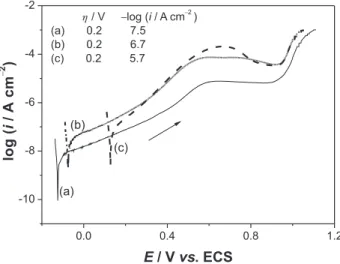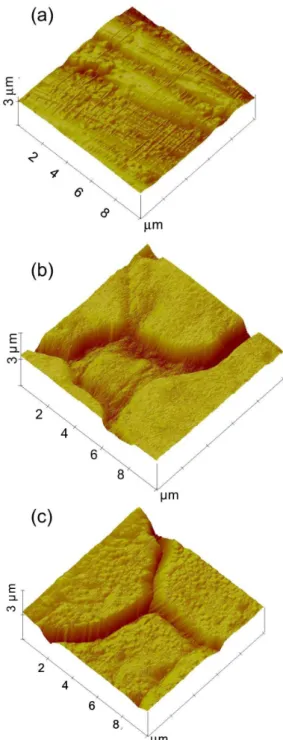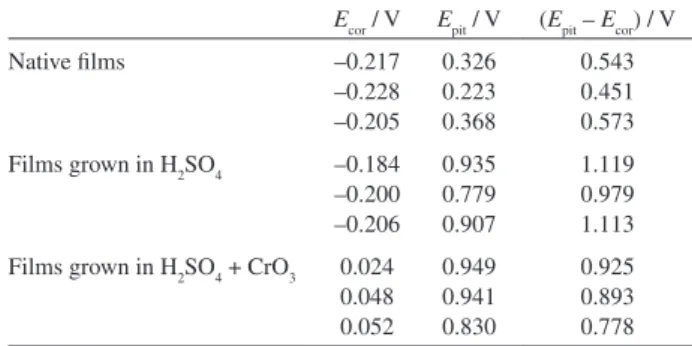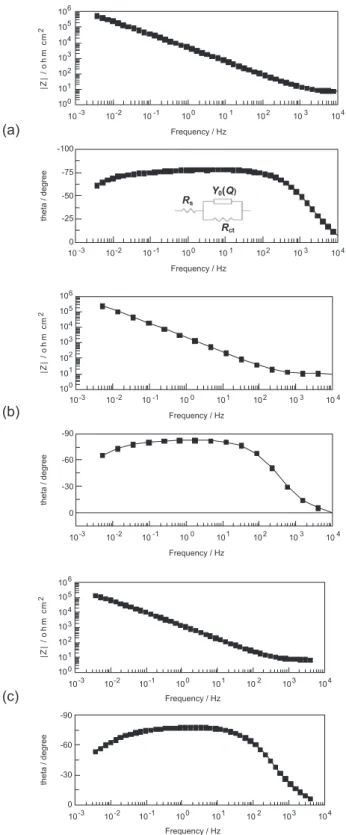Ar
ti
cle
0103 - 5053 $6.00+0.00
*e-mail: bocchi@power.ufscar.br
Pitting Corrosion Resistance of Coloured Oxide Films Grown on Stainless Steel in
Sulphuric Acid in the Presence and Absence of Chromic Acid
Karina O. Vasconcelos,a Nerilso Bocchi*,a and Alda M. Simõesb
aDepartment of Chemistry, Universidade Federal de São Carlos, CP 676, 13560-970 São Carlos-SP, Brazil
bChemical and Biological Department, Instituto Superior Técnico, Av. Rovisco Pais, 1049-001 Lisboa Codex, Portugal
Neste trabalho foi avaliada a resistência à corrosão por pites de ilmes de óxidos coloridos crescidos sobre aço inoxidável AISI 304 em H2SO4 e H2SO4 + CrO3. A morfologia e topograia dos ilmes foram examinadas por MEV (microscopia eletrônica de varredura) e AFM (microscopia de força atômica), respectivamente. As caracterizações eletroquímicas foram conduzidas por curvas de polarização e medidas de impedância em tampão borato pH 9,2. A corrosão por pites foi avaliada por curvas de polarização realizadas na mesma solução contendo NaCl. Todos os ilmes coloridos apresentaram valores semelhantes de Epite, mas maiores que dos ilmes não coloridos. Os valores de (Epite − Ecor) resultaram no intervalo de 0,45-0,57 V; 0,78-0,92 V e 0,98-1,12 V para ilmes nativos e crescidos na presença e ausência de ácido crômico, respectivamente. Portanto, os ilmes crescidos sobre o aço na ausência de ácido crômico apresentaram o maior intervalo de potencial livre de corrosão por pites.
In this work, pitting corrosion resistance of coloured oxides ilms grown on AISI-304 stainless-steel in H2SO4 and H2SO4 + CrO3 was evaluated. Surface morphology and topography of the ilms were examined by SEM (scanning electron microscopy) and AFM (atomic force microscopy), respectively. Electrochemical characterizations were conducted by polarization curves and impedance measurements in borate buffer pH 9.2. The pitting corrosion was evaluated by polarization curves carried out in the same solution containing NaCl. All coloured ilms presented similar values of Epit, but they were higher than those for non-coloured ones. The values of (Epit − Ecor) were in the range of 0.45-0.57 V, 0.78-0.92 V and 0.98-1.12 V for native ilms and ilms grown in the presence and absence of chromic acid, respectively. Therefore, the ilms grown on stainless steel in the absence of chromic acid presented the highest potential range free of pitting corrosion.
Keywords: pitting corrosion, coloured oxide ilms, triangular current scan method, sulphuric acid, sulphuric and chromic acids
Introduction
Coloured stainless steel has introduced a new aesthetic pattern to architecture and decoration since it has good performance in aggressive environments. These coloured oxide ilms can be grown on the stainless-steel surface by chemical oxidation1-3 or electrochemical oxidation.4-10
The chemical process consists of immersion in a hot, concentrated solution of chromic and sulphuric acids and leads to the formation of thick ilms that seem to result from the dissolution of steel and concomitant reduction of chromic acid.1 However, chromic-sulphuric acid
solutions are hazardous when used at high temperatures, and therefore the use of electrochemical techniques is a potentially interesting alternative. Ogura et al.9 proposed
to grow ilms with interference colours by applying either alternating potential pulses8 or a triangular current scans
to a stainless steel substrate in chromic and sulphuric acid solution at room temperature.
However, it is well known that chromic acid contains CrVI
which is highly toxic.11 Thus far, only two distinct research
groups have proposed to carry out the growth of oxide ilms (colouration) on stainless steel using only sulphuric acid.4,12-15 According to the methodology described by
Fujimoto et al.4,12-14 specimens of type 304-stainless steel are
immersed in deaerated 0.5 and 5.0 mol L−1 H
2SO4 at 50
and immediately submitted to a square-waves polarization for 40 min. In the work of Zhang et al.15 samples of the same
steel were coloured in 2.5 mol L−1 H
2SO4 at 70
oC by applying
modulated square-wave potential pulses.
As described above, the two propositions for colouring stainless steels in sulphuric acid employ electrochemical techniques under controlled-potential conditions, but in industrial applications it is much easier to control the current. So, in previous work,16 the colouration of stainless steel was
investigated only in 5 mol L−1 H
2SO4 at different temperatures
by applying triangular current scans. Thickest oxide ilms were formed on stainless steel samples in 5 mol L-1
H2SO4, kept at 50 oC, using the following experimental
parameters: imin = −0.81 mA cm−2, i
max = 1.40 mA cm
−2 and
t = 2.5 s. The electrolysis of the steel samples carried out in these experimental conditions lead to oxide ilms whose thicknesses increased (<100-280 nm) with the electrolysis time (20-60 min). The predominant colours were gold, red and blue, although intermediate colours (greenish yellow, greenish blue and brown) were also observed, depending on the electrolysis time.
There seems to be an agreement that the corrosion resistance is increased for coloured oxide ilms formed on stainless steel using sulphuric acid in the presence of chromic acid. Wang et al.17,18 characterized the pitting
corrosion of coloured samples obtained by chemical, INCO (chemical colouring + electrolytic hardening) and electrochemical (square-wave potential pulses) processes, using anodic polarization and electrochemical impedance spectroscopy in a HCl solution. Their experimental results showed that the pitting resistance of the coloured samples increased in the following process order: chemical < electrochemical < INCO. In previous work,19 it was
evaluated the resistance to uniform and pitting corrosion of AISI-304 stainless-steel samples coloured by alternating potential pulses with different amplitudes and electrolysis times. All the different coloured samples were less susceptible to uniform corrosion than the non-coloured ones. A comparative study of the resistance to pitting corrosion for differently coloured AISI-304 stainless-steel samples (chemical and electrochemical methods) was also reported previously.20 It was concluded that coloured oxide
ilms have a protective effect against pitting corrosion independently of the colouring methods under accelerated test in dearated 0.62 mol L-1 NaCl solution and for the
irst hours of extended immersion tests in 0.40 mol L-1
HCl solution, when compared with non-coloured ilm. For longer exposition times (8-10 h) the non-coloured and coloured steel samples present the same behaviour.
On the other hand, for steel samples coloured in the absence of chromic acid, Fujimoto etal.12 have reported
that ilms formed in this condition never inhibited any initiation of localised corrosion in chloride solution. From TEM (transmission electron microscopy) micrographs, these authors have concluded that the ilm seems to contain many pathways, which permit subsequent growth without any decrease in the rate and penetration of water and/or ions.
As highlighted hereinbefore, the colouring methods constitute an effective way of increasing the corrosion resistance and applications of stainless steel. Moreover, as far as we known there are no studies on the pitting corrosion resistance of stainless steels coloured using only sulphuric acid and the triangular current scan method. Thus, in the present work a comparative study of the pitting corrosion resistance of coloured oxides ilms grown by triangular current scan method in sulphuric acid with and without chromium acid is reported.
Experimental
Material and electrochemical colouring
A 150 mL conventional three-electrode electrochemical cell was used for colouring the stainless-steel samples, which were the working electrodes. Two spiral Pt wires were used as auxiliary electrodes, and an Hg/Hg2SO4 electrode in a 5.0 mol L-1 H
2SO4 solution as reference.
Stainless-steel samples 2 × 5 cm in size were cut from a sheet (0.5 mm thick) of bright annealed austenitic AISI-304 stainless steel (ACESITA # 2B) with the following mass composition: Cr 17.7%, Ni 7.4%, Mn 1.2%, Si 0.4%, S 0.01%, C 0.07%, and Fe balanced.
The stainless-steel samples were firstly degreased for 10 min with acetone under ultrasonic stirring and then rinsed in distilled water. After being electroreduced (i = −1.0 mA cm-2) for 20 min in an aqueous 1.0 mol L-1
HNO3 solution,9 the pre-treated steel samples were then
immersed in an aqueous 5.0 mol L-1 H
2SO4 solution with
and without 2.5 mol L-1 CrO
3 and immediately submitted
to a triangular current scan pre-programmed in the GPES software used to control an Autolab PGSTAT30 potentiostat/galvanostat from Eco Chemie. After colouring, the stainless-steel samples were removed from the solution, rinsed thoroughly with distilled water and dried in air.
The experimental parameters of the triangular current scan method used for colouring the steel samples in 5.0 mol L-1 H
2SO4 solution with 2.5 mol L
-1 CrO
3 were the
same those employed by Ogura et al.9 The current density
values varied from imin = −0.81 mA cm-2 to i
max = 2 mA cm
-2.
For electrolyses carried out in an aqueous 5.0 mol L-1
H2SO4 solution only, the experimental parameters of the triangular current scanmethod were chosen following the results previously reported by Vasconcelos et al.16 The current density values varied from imin = −0.81 mA cm-2 to
imax = 1.4 mA cm-2 at 50 °C. In order to obtain ilms with
comparable thickness with those grown in the presence of chromic acid, a time of electrolysis of 60 min were used. Films of thickness near of 240 nm were obtained in this case.
Characterisation of the ilms
The thickness of the coloured oxide ilms grown on the stainless-steel samples were estimated by measuring their spectral relectance in the visible region (400-700 nm) using a spectra Gretag Macbeth-2180 spectrophotometer.
The surface morphology of the coloured oxide ilms grown by triangular current scan method in sulphuric acid with and without chromium acid was examined by scanning electron microscopy (SEM). The apparatus was the Digital Instruments IIIA. AFM images of these same ilms were also obtained using a Nanoscope system, operating in contact mode with a silicon tip.
Electrochemical measurements
The electrochemical studies, in order to evaluate the protective effect of the oxide ilms grown on the stainless-steel samples against pitting corrosion, were conducted at room temperature by potentiodynamic polarization curves. For such, a conventional electrochemical cell with three electrodes was used. The counter electrode was a Pt-spiral and a saturated calomel electrode (SCE) was used as reference for the potential measurements. A Gamry FAS1 Femtostat potentiostat controlled by the software EIS 300 was used to obtain the polarization curves. In order to eliminate edge effects, epoxy resin was applied in all coloured samples; only one of the faces (square area of 1 cm2) was not covered. The coloured samples
were immersed in an aqueous borate buffer solution of pH 9.2 [0.050 mol L-1 H
3BO3 (Merck p.a.) + 0.075 mol L -1
Na2B4O7•10H
20 (Riedel-de Haen analytical reagent)]
without and with 0.7 mol L-1 NaCl (Panreac), at room
temperature, and kept at the open circuit potential. After the corrosion potential was practically stable (ca. 40 min), the steel sample was polarized to more negative of ca. 30 mV than the corrosion potential. The potentiodynamic polarization curve was then immediately initiated in the anodic direction (up to ca. 1.1 V vs. SCE) at a sweep rate of 1 mV s-1. At least three polarization curves were always
obtained for each one of the steel samples electrolysed in a
given experimental condition. The results were normalized to the geometrical area of the samples.
EIS (electrochemical impedance spectroscopy) measurements were also conducted for the coloured-steel samples in borate buffer solution pH 9.2 containing 0.7 mol L-1 NaCl. These measurements were obtained
at the open circuit potential, applying a 10 mV (rms) ac signal and scanning the 100 kHz-10 mHz frequency range. The analysis was performed in Gamry FAS1 Femtostat potentiostat controlled by the software EIS 300. The results were also normalized to the samples geometrical area.
Results and Discussion
Typical potentiodynamic polarization curves, obtained in borate buffer pH 9.2 for steel samples in the three situations investigated (as received and coloured in the presence and absence of chromic acid), are shown in Figure 1. Comparing two of these curves (a and c) with those previously reported,21 two main differences are observed for
potentials lower than 0.6 V vs. ECS. The curves in Figure 1 present lower values of current density and higher values of corrosion potential. This possibly occurs because the edge effects were eliminated by applying epoxy resin in the steel samples. Therefore, the oxide ilms (native and grown on steel samples) are more protective in the present work. Among the curves in Figure 1, the values of current density are higher for coloured than non-coloured samples for the same overpotential in the passive region (see values of –log i for h = 0.2 V in the igure). The increases in the values of current density are close to one and two order of magnitude for steel samples coloured in H2SO4 and H2SO4
Figure 1. Typical potentiodynamic polarization curves (n= 1 mV s-1)
obtained at room temperature in a borate buffer solution pH 9.2 for AISI-304 stainless-steel (a) non-coloured sample (as received) and previously coloured samples using the triangular current scans method in (b) 5.0 mol L-1 H
2SO4 and (c) 5.0 mol L -1 H
2SO4 + 2.5 mol L -1 CrO
+ CrO3, respectively. These results indicate that oxide ilms with distinct surface areas were grown on the steel surface. So, the oxide ilms grown in H2SO4 + CrO3 have more surface area than those grown in only H2SO4. Figure 2 shows typical micrographs obtained for steel samples in the three situations investigated (as received and coloured in the presence and absence of chromic acid). A compact and uniform oxide ilm is spontaneously formed on steel surface (Figure 2a). On the other hand, highly porous
ilms are grown on steel by the triangular current scan method (Figures 2b and c). However, these igures do not distinguish differences in porosity between oxide ilms grown in H2SO4 with and without CrO3. Kikuti et al.21
have also observed by SEM the growth of highly porous oxide ilms in H2SO4 + CrO3 when the triangular current scan method was employed. Figure 3 presents typical surface topographies obtained for steel samples in the three
Figure 2. Typical micrographs obtained by SEM for AISI-304
stainless-steel (a) non-coloured (as received) and previously coloured samples using the triangular current scans method in (b) 5.0 mol L-1 H
2SO4 and (c) 5.0 mol L-1 H
2SO4 + 2.5 mol L -1 CrO
3.
Figure 3. Typical surface topographies obtained by AFM for AISI-304
stainless-steel (a) non-coloured (as received) and previously coloured samples using the triangular current scans method in (b) 5.0 mol L-1 H
2SO4 and (c) 5.0 mol L-1 H
2SO4 + 2.5 mol L -1 CrO
situations investigated (as received and coloured in the presence and absence of chromic acid). From roughness analysis in various AFM images of different sizes (100 µm2,
2,500 µm2 and 10,000 µm2) the ilms grown either in H
2SO4
or H2SO4 + CrO3 reveal surface areas 6-20% higher than AFM image areas; whereas oxide ilms spontaneously formed on steel present surface areas of 3-5% higher than AFM image areas. Therefore, only differences in porosity may explain why oxide ilms grown in H2SO4 + CrO3 have more surface area than those grown in only H2SO4 as observed by polarization curves (Figure 1).
The pitting corrosion susceptibility of the oxide ilms formed on the stainless-steel samples in the three situations (as received and grown in the presence and absence of chromic acid) was evaluated by potentiodynamic polarization curves carried out in a borate buffer solution pH 9.2, containing chloride ions (Figure 4). After these measurements, the visual colour of all steel samples was practically unchanged. As already pointed out in Figure 1, the values of current density are also higher for coloured (near one order of magnitude) than non-coloured samples for the same overpotential in the passive region. The values of Ecor, Epitand (Epit−Ecor) extracted from the potentiodynamic polarization curves of Figure 4 for steel samples non-coloured and previously coloured using the triangular current scan method are listed in Table 1.All coloured steel samples present similar values of Epit but they are higher than those for non-coloured ones. By the other hand, the values of (Epit−Ecor) are in the range of 0.45 V-0.57 V, 0.78 V-0.92 V and 0.98 V-1.12 V for native ilms (very thin ilms) and ilms grown (thicker ilms) in the presence and absence of chromic acid, respectively. These
results show that the ilms grow on stainless steel in the absence of chromic acid present the highest potential range free of pitting corrosion. So, the ilms grown on stainless steel in this condition are more protective against pitting corrosion. A possible explanation for these results can be given assuming that the porous of coloured ilms are of the isolated type, i.e. the porous begin in the top of the ilms but do not reach the steel substrat.22 Moreover, oxide
ilms with lower porous density may also possibly explain the results for ilms grown in H2SO4, as they represent a greater physical barrier. Less porosity leads to less free pathways for penetration of water and ions and so, less pitting corrosion susceptibility.
As shown in Figure 5, impedance spectra were also obtained at the open circuit potential in borate buffer pH 9.2 containing 0.7 mol L-1 NaCl for steel samples in the three
situations investigated (as received and coloured in the presence and absence of chromic acid). It is important to mention that these impedance spectra are similar those obtained at the same buffer solution in the absence of chloride ions.21 As previously reported, the impedance response of the
ilms was also capacitive for most of the spectrum.
Like in a previous work,21 the itting of capacitive part
of the spectra was also made using a constant phase element (CPE), whose impedance is given by:
where w is the angular frequency, Y0 the frequency-independent parameter, n related to the phase angle and gives information on the type of element (n = 1 for a capacitor and n = 0 for a resistor) and j = (−1)1/2. For native ilms and
ilms grown in the presence and absence of chromic acid, the equivalent circuit (EC) as well as the results of the itting is presented in Figure 5 and Table 2. The values of Y0 were
Figure 4. Typical potentiodynamic polarization curves (n = 1 mV s-1)
obtained at room temperature in a borate buffer solution pH 9.2 containing 0.7 mol L-1 NaCl for AISI-304 stainless-steel (a) non-coloured sample (as received) and previously non-coloured samples using the triangular current scans method in (b) 5.0 mol L-1 H
2SO4 and (c) 5.0 mol L-1 H
2SO4 + 2.5 mol L -1 CrO
3.
Table 1. Values of Ecor, Epit and (Epit – Ecor) from potentiodynamic polarization curves obtained in borate buffer solution pH 9.2 + 0.7 mol L-1 NaCl for AISI-304 stainless-steel non-coloured and previously coloured samples using the triangular current scan method
Ecor / V Epit / V (Epit – Ecor) / V
Native ilms –0.217
–0.228 –0.205
0.326 0.223 0.368
0.543 0.451 0.573
Films grown in H2SO4 –0.184 –0.200 –0.206
0.935 0.779 0.907
1.119 0.979 1.113
Films grown in H2SO4 + CrO3 0.024 0.048 0.052
0.949 0.941 0.830
Table 2. Values used in the itting of EIE spectra
Y0 (Q) /
(F cm-2 s-n)
n Rct / (Ω cm2)
X2
Native ilms 4.0×10-5 0.87 1.6×106 2.1×10-3
Films grown in H2SO4 8.4×10-5 0.92 7.5×105 2.2×10-3
Films grown in H2SO4 + CrO3
1.5×10-4 0.86 2.7×105 1.8×10-3
Figure 5. Impedance spectra obtained at the open circuit potential and
room temperature in a borate buffer solution pH 9.2 containing 0.7 mol L-1 NaCl for AISI-304 stainless-steel (a) non-coloured sample (as received) and previously coloured samples using the triangular current scans method in (b) 5.0 mol L-1 H
2SO4 and (c) 5.0 mol L -1 H
2SO4 + 2.5 mol L -1 CrO
3. practically the same for native ilm and ilm grown in H2SO4. Unlikely, the value of Y0 for the ilm grown in H2SO4 + CrO3 was more than one order of magnitude higher than those of
the other ilms. Since there was no change in the equivalent circuit of the spectrum and the value of Y0 is proportional to the area, this increase suggests that the area contributing to the values of Y0 has increased. The area increase can be explained by an increased surface area in the ilm, i.e., by the thickness of a more porous ilm, as suggested hereinbefore. The fact that there is only one time constant in the spectrum also suggests identical properties for the walls and the bottom of the pores.
Rct accounts for the charge transfer resistance at the ilm surface. Its estimate is affected by a relatively high error since its response comes mostly below the low frequency of the spectrum. In spite of this, the fact that it decreases for ilms grown in H2SO4 + CrO3 is in agreement with the development of an extended area. These results indicate that the porosity of the ilms grown on stainless steel by the triangular current scan method increases with CrO3 addition, which corroborates the interpretation given for the obtained results of pitting corrosion.
Conclusions
Thick passive films showing interference colours have been grown on stainless steel in aqueous solution of 5.0 mol L-1 H
2SO4 and 5.0 mol L
-1 H
2SO4 + 2.5 mol L
-1 CrO
3
by the triangular current scan method. Films of thickness near of 240 nm and 260 nm were formed in H2SO4 (at 50 °C) and H2SO4 + CrO3 (at 25 °C), respectively. All coloured ilms presented similar values of Epit but they were higher than those for non-coloured ones. The values of (Epit−Ecor) were in the range of 0.45-0.57 V, 0.78-0.92 V and 0.98-1.12 V for native ilms and ilms grown in the presence and absence of chromic acid, respectively. Therefore, the ilms grown on stainless steel in the absence of chromic acid presented the highest potential range free of pitting corrosion. This was explained by a ilm formation with lower number of porous as suggested by impedance measurements.
Acknowledgements
the inancial support of this work. The authors also thank Prof. Dr. Rodrigo del Rio from Pontifícia Universidad Católica de Chile for the AFM images.
References
1. Evans, T. E.; Hart, A. C.; James, H.; Smith, V. A.; Trans. Inst. Met. Finish.1972, 51, 108.
2. Evans, T. E.; Corros. Sci.1977, 17, 105.
3. Evans, T. E.; Hart, A. C.; Skedgell, A. E.; Trans. Inst. Met. Finish.1973, 50, 77.
4. Fujimoto, S.; Shibata, T.; Wada, K.; Tsutae, T.; Corros. Sci. 1993, 35, 147.
5. Lin, C. J.; Duh, J. G.; Surf. Coat. Technol.1994, 70, 79. 6. Lin, C. J.; Duh, J. G.; Surf. Coat. Technol.1995, 73, 52. 7. Lin, C. J.; Duh, J. G.; Surf. Coat. Technol.1996, 85, 175. 8. Ogura, K.; Sakurai, K.; Uehara, S.; J. Electrochem. Soc.1994,
141, 648.
9. Ogura, K.; Lou, W.; Nakayama, M.; Electrochim. Acta1996,
41, 2849.
10. Ogura, K.; Tsujigo, M.; Sakurai, K.; Yano, J.; J. Electrochem. Soc.1993, 140, 1311.
11. Rajeshwar, K.; Ibanez, J. G.; Environmental Electrochemistry, Academic Press: San Diego, 1997.
12. Fujimoto, S.; Shibata, T.; Mater. Sci. Forum1995, 185, 741.
13. Fujimoto, S.; Kiyoshi, T.; Shibata, T.; J. Electroanal. Chem. 1999, 473, 265.
14. Fujimoto, S.; Kawachi, S.; Nishio, T.; Shibata, T.; Electrochim. Acta 2001, 47, 543.
15. Zhang, J. X.; Chen, J.; Qiao, Y. N.; Cao, C. N.; Trans. Inst. Met. Finish.1999, 77, 106.
16. Vasconcelos, K. O.; Bocchi, N.; Rocha, R. C.; Biaggio, S. R.;
J. Electrochem. Soc. 2005, 152, B491.
17. Wang, J. H.; Duh, J. G.; Shih, H. C.; J. Mater. Sci. Lett.1995,
14, 53.
18. Wang, J. H.; Duh, J. G.; Shih, H. C.; Surf. Coat. Technol.1996,
78, 248.
19. Conrrado, R.; Bocchi, N.; Rocha-Filho, R. C.; Biaggio, S. R.;
Electrochim. Acta2003, 48, 2417.
20. Kikuti, E.; Conrrado, R.; Bocchi, N.; Biaggio, S. R.; Rocha-Filho, R. C.; Electrochim. Acta2004, 15, 472.
21. Kikuti, E.; Bocchi, N.; Pastol, J. L.; Ferreira, M. G.; Montemor, M. F.; Da Cunha Belo, M.; Simões, A. M.; Corr. Sci.2007, 49, 2303.
22. Kutzelnigg, A.; Plating1961, 48, 382.
Received: April 30, 2009
Web Release Date: December 3, 2009



